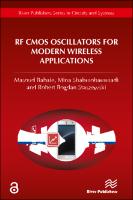RF CMOS Oscillators for Modern Wireless Applications
Proposal review
| dc.contributor.author | Babaie, Masoud | |
| dc.contributor.author | Shahmohammadi, Mina | |
| dc.contributor.author | Staszewski, Robert Bogdan | |
| dc.date.accessioned | 2022-11-28T16:04:27Z | |
| dc.date.available | 2022-11-28T16:04:27Z | |
| dc.date.issued | 2019 | |
| dc.identifier | ONIX_20221128_9781000794434_38 | |
| dc.identifier.uri | https://library.oapen.org/handle/20.500.12657/59757 | |
| dc.description.abstract | While mobile phones enjoy the largest production volume ever of any consumer electronics products, the demands they place on radio-frequency (RF) transceivers are particularly aggressive, especially on integration with digital processors, low area, low power consumption, while being robust against process-voltage-temperature variations. Since mobile terminals inherently operate on batteries, their power budget is severely constrained. To keep up with the ever increasing data-rate, an ever-decreasing power per bit is required to maintain the battery lifetime. The RF oscillator is the second most power-hungry block of a wireless radio (after power amplifiers). Consequently, any power reduction in an RF oscillator will greatly benefit the overall power efficiency of the cellular transceiver. Moreover, the RF oscillators' purity limits the transceiver performance. The oscillator's phase noise results in power leakage into adjacent channels in a transmit mode and reciprocal mixing in a receive mode. On the other hand, the multi-standard and multi-band transceivers that are now trending demand wide tuning range oscillators. However, broadening the oscillator’s tuning range is usually at the expense of die area (cost) or phase noise. The main goal of this book is to bring forth the exciting and innovative RF oscillator structures that demonstrate better phase noise performance, lower cost, and higher power efficiency than currently achievable. Technical topics discussed in RF CMOS Oscillators for Modern Wireless Applications include: Design and analysis of low phase-noise class-F oscillators Analyze a technique to reduce 1/f noise up-conversion in the oscillators Design and analysis of low power/low voltage oscillators Wide tuning range oscillators Reliability study of RF oscillators in nanoscale CMOS | |
| dc.language | English | |
| dc.subject.classification | thema EDItEUR::P Mathematics and Science::PH Physics::PHD Classical mechanics::PHDY Energy | en_US |
| dc.subject.classification | thema EDItEUR::T Technology, Engineering, Agriculture, Industrial processes::TJ Electronics and communications engineering::TJK Communications engineering / telecommunications::TJKT Telephone technology::TJKT1 Mobile phone technology | en_US |
| dc.subject.other | Energy | |
| dc.subject.other | Mobile phone technology | |
| dc.title | RF CMOS Oscillators for Modern Wireless Applications | |
| dc.type | book | |
| oapen.identifier.doi | 10.1201/9781003339311 | |
| oapen.relation.isPublishedBy | 7b3c7b10-5b1e-40b3-860e-c6dd5197f0bb | |
| oapen.relation.isFundedBy | 3983007a-5726-4f1e-b9df-3fbc771f2916 | |
| oapen.relation.isbn | 9781000794434 | |
| oapen.relation.isbn | 9788793609495 | |
| oapen.relation.isbn | 9781003339311 | |
| oapen.imprint | River Publishers | |
| oapen.pages | 222 | |
| oapen.grant.number | [...] | |
| peerreview.anonymity | Single-anonymised | |
| peerreview.id | bc80075c-96cc-4740-a9f3-a234bc2598f1 | |
| peerreview.open.review | No | |
| peerreview.publish.responsibility | Publisher | |
| peerreview.review.stage | Pre-publication | |
| peerreview.review.type | Proposal | |
| peerreview.reviewer.type | Internal editor | |
| peerreview.reviewer.type | External peer reviewer | |
| peerreview.title | Proposal review | |
| oapen.review.comments | Taylor & Francis open access titles are reviewed as a minimum at proposal stage by at least two external peer reviewers and an internal editor (additional reviews may be sought and additional content reviewed as required). |

